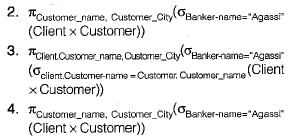Test: Relational Algebra, Tuple Calculus & SQL- 2 - Computer Science Engineering (CSE) MCQ
15 Questions MCQ Test - Test: Relational Algebra, Tuple Calculus & SQL- 2
Given relations R(w, x) and S(y, z), the result of
SELECT DISTINCT w,x
FROM R, S
Is guaranteed to be same as R, if
SELECT DISTINCT w,x
FROM R, S
Is guaranteed to be same as R, if
Branch-scheme = (Branch - name, assets, branch- city)
Customer-scheme = (Customer-name, street, customer- city)
Deposit-scheme = (Branch-name, account-number, customer-name, balance)
Borrow-scheme = (Branch-name, loan-number, customer-name, amount)
Client-scheme = (Customer-name, banker-name)
Using relational algebra, the query that finds customers who have a balance of over 1000 is
Customer-scheme = (Customer-name, street, customer- city)
Deposit-scheme = (Branch-name, account-number, customer-name, balance)
Borrow-scheme = (Branch-name, loan-number, customer-name, amount)
Client-scheme = (Customer-name, banker-name)
Using relational algebra, the query that finds customers who have a balance of over 1000 is
Branch-scheme = (Branch - name, assets, branch- city)
Customer-scheme = (Customer-name, street, customer- city)
Deposit-scheme = (Branch-name, account-number, customer-name, balance)
Borrow-scheme = (Branch-name, loan-number, customer-name, amount)
Client-scheme = (Customer-name, banker-name)
Which of the following queries finds the clients of banker Agassi and the city they live in?


Customer-scheme = (Customer-name, street, customer- city)
Deposit-scheme = (Branch-name, account-number, customer-name, balance)
Borrow-scheme = (Branch-name, loan-number, customer-name, amount)
Client-scheme = (Customer-name, banker-name)
Which of the following queries finds the clients of banker Agassi and the city they live in?


Branch-scheme = (Branch - name, assets, branch- city)
Customer-scheme = (Customer-name, street, customer- city)
Deposit-scheme = (Branch-name, account-number, customer-name, balance)
Borrow-scheme = (Branch-name, loan-number, customer-name, amount)
Client-scheme = (Customer-name, banker-name)
Which of the following tuple relational calculus finds all customers who have a loan amount of more than 1200?
Branch-scheme = (Branch - name, assets, branch- city)
Customer-scheme = (Customer-name, street, customer- city)
Deposit-scheme = (Branch-name, account-number, customer-name, balance)
Borrow-scheme = (Branch-name, loan-number, customer-name, amount)
Client-scheme = (Customer-name, banker-name)
Which of the following Domain relational calculus finds all customers who have a loan amount of over 1200?
Consider the set of relations given below and the SQL query that follows:
Students: (Roll_number, Name, date_of_birth)
Courses: (Course_number, Course_name, Instructor)
Grades: (RolL_number, Course_number, Grade)
SELECT DISTINCT Name
FROM Students, Courses, Grades
WHERE Students. RolLnumber = Grades.
RolLnumber
ANDCourse.lnstructor = Korth
AND Courses.Course_number =. Grades. Course_number AND Grades.Grade = A
Which of the following sets is computed by the above query?
Consider the following relational schema pertaining to a students database.
Student: (rollno. name, address)
Enroll: (rollno. courseno. coursename) Where the primary keys are shown underlined. The number of tuples in the Student and the Enroll tables are 120 and 8 respectively. What are the maximum and the minimum number of tuples that can be present in (Student * Enroll), where * denotes natural join?
The employee information in a company is stored in the relation. Assume name is the primary key:
Employee: (name, sex, salary, deptName)
Consider the SQL query;
SELECT deptName
FROM Employee
WHERE sex = M
GROUP By deptName
HAVING avg(salary) > (SELECT avg(salary)
FROM Employee)
It returns the names of the departments in which the average salary.
The SQL expression :
SELECT distinct 7.branch_name
FROM branch T, branch S
WHERE T.assets >S.assets and S.branch_city = "PONDICHERRY”
Finds the names of
If P and Q are predicates and P is the relational algebra expression, then which of the following equivalence are valid?
Which of the following query transformation (i.e. replacing the LHS expression by the RHS expression) is incorrect? R1 and R2, are relations, C1 C2 are selection conditions and A1 A2 are attributes of R1.
Consider a following declaration:

Then to find the customers who appears in r2, with every branch name in r1 the query is:
With the help of which of the following relations operation set we can perform division on relations?
Which of the following relational calculas expressions is not safe?


 (Deposit), Now, we have to select those customers name who have balance over 1000 which can be obtained by simply projecting customer name in above subquery.
(Deposit), Now, we have to select those customers name who have balance over 1000 which can be obtained by simply projecting customer name in above subquery.
 borrow (t [custome _name ])=s [customer_name]
borrow (t [custome _name ])=s [customer_name]




















